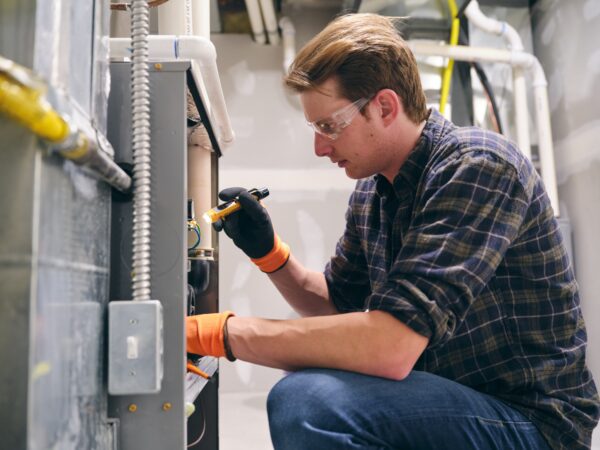
The process of building a new custom home is an exciting journey that provides you and your family members with the unique opportunity to tailor living spaces to meet your specific needs and desires. The thrill of being able to customize features such as appliances, floor plans, lighting, and decor allows you to create a personal yet functional living environment that fits your family and lifestyle perfectly. From selecting the perfect color palette for a child’s bedroom to choosing custom cabinetry for entertainment spaces, every detail is an exciting opportunity to make your home truly unique and special.
What About Essential Appliances?
Part of your custom home plan should include the addition of certain essential appliances such as water heaters, plumbing systems, and HVAC systems. Installing these appliances is an important step in creating a comfortable living environment for you and your loved ones. As you consider which system is best for your new layout and lifestyle, take these key points into consideration.
Energy Efficiency
Choosing a new HVAC system with a high SEER, or Seasonal Energy Efficiency Ratio, will save you money on energy costs and reduce your carbon footprint. Units with a high SEER rating are environmentally friendly, reducing the amount of energy needed to heat and cool a home. That contributes to a cleaner, more sustainable future for all. High-efficiency systems run less frequently, reducing wear and tear on various components and potentially extending your unit’s lifespan. Look for a high-efficiency option when choosing a system for your new house.
Size
Size is an important factor when choosing the right system for your property. A system that’s too small will struggle to keep up with heating and cooling demands, resulting in wide temperature swings and poor indoor air quality. On the other hand, if your system is too large, it will waste energy and create excess moisture, which leads to mold and mildew growth. The right size system will be energy-efficient, contribute to a longer lifespan, and yield you significant energy cost savings over time.
Zoning
Zoning is the process of dividing a home into separate areas, each with its own thermostat, to improve temperature control and energy efficiency. With zoning, each area of your house can be set to different temperatures, allowing you to place focus on rooms that are used most frequently. Zoning can also help to improve indoor air quality by reducing the circulation of allergens, pollutants, and other irritants throughout your home. By reducing the need for your HVAC system to regulate your whole house, it can increase your unit’s energy efficiency, thus improving function and longevity.
Maintenance
Consider your unit and how it will need to be maintained and serviced over time. Putting together a regular maintenance schedule will save you time and money as you improve its performance and reduce your energy costs. Enlist the help of a licensed HVAC contractor to give you tips on how to best care for and maintain your unit.
Professional Installation
New construction HVAC installation should be left up to professionals. Incorrect steps and improper use of tools can be dangerous, posing a risk to you and to those using the unit. With professional installation, you’re covered under warranty against any issues that may arise with installation or service. Professionals have the knowledge and expertise to troubleshoot and resolve any problems that could happen during the installation process.
HVAC Installation Steps
Several steps will be taken to ensure that you have the right unit installed in your new home.
Sizing
One of the first things your HVAC technicians will do is determine a proper size system for your home. Several factors are taken into account when sizing your house for a system, including:
- The size and square footage of your property
- The number of occupants
- Local climate and weather patterns
- Type of windows and weatherproofing that exist in the house
Choosing Outdoor Space for Your AC
Choosing an outdoor space for your AC unit is an important part of making sure your whole unit functions as intended. Your technician will choose a spot that’s as close to level as possible, making sure there’s plenty of clearance to allow for maintenance and airflow. Measures will also be taken to pick a space that’s somewhat sheltered from the elements like rain, wind, and snow. The ideal location for an outdoor unit is away from bedroom windows (so as not to disturb sleep), sheltered from foot traffic, and easily accessible for inspections, repairs, and maintenance.
Installing The Central Unit
Installation of your indoor central unit begins with planning its location based on the placement of windows and doors. Next, technicians will prepare a supportive environment that may involve running electrical and plumbing, installing a concrete slab for the unit, and hooking up all components in preparation for connection to ductwork. Once these preparation measures have been put in place, it’s time to move in the unit and test it for efficacy and safety. You’ll then be ready to plan and prepare for the installation of ductwork in your home.
Ductwork Installation
Ductwork installation in new construction typically involves the following steps. Each of these steps should be performed by a licensed, professional HVAC technician to ensure that your system is installed correctly.
Design
The first step toward installing a high-quality ductwork system for your HVAC unit is design. Your technicians will need to determine the size and layout of planned ductwork, taking into consideration factors such as your home size, the number of rooms, and the type of system you’ve chosen.
Layout
Once design and preparation are finished, then ductwork is laid out, with the main supply ducts running from the furnace or air handler to various rooms of the home. Return ducts are installed running from rooms back to the air exchanger.
Installation
Ductwork is then installed, with each section being connected using a series of screws, tape, or mastic. Ducts are then sealed completely to prevent leaking and moisture from taking hold.
Testing and Final Adjustments
Testing and making final adjustments to your network is a very important part of the process. This ensures that all aspects of your unit are working properly and that you’re set up for heating and cooling efficiency in your new home.
HVAC Timing
The process of installing a new HVAC system in a new construction home typically takes anywhere from several days to a few weeks, depending on the complexity of the installation and the size and layout of your house. Issues such as the type of HVAC system you use, the complexity of ductwork design, and even the availability of a qualified HVAC contractor all play a part in your unique HVAC timeline. In general, it’s best to plan for several weeks from start to finish to allow for planning, preparation, installation, and any other hiccups that may come up that require modification of your original plan.
Consulting your HVAC professional for updates and information on your HVAC installation will allow you to stay informed and understand the process that will inevitably contribute to a more comfortable, energy-efficient home for you and your loved ones.
We’re Here for Your New Home Construction Needs!
Beyer Air Conditioning & Heating is proud to serve residents of San Antonio and the surrounding areas. We offer heating and cooling installation, maintenance and repair, along with indoor air quality inspections, ductless mini-split service, water heater and heat pump services, and more. We have the knowledge and skills to handle all of your HVAC and construction needs. Contact us today for more information or to schedule an HVAC installation in your new custom home!



